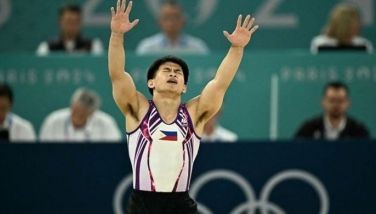Mime artist Iinuro Naoki: His silence was eloquent / Reyes concerts, NAMCYA tilts
Iinuro Naoki’s performance at the RCBC auditorium last Tuesday proved that a mime can have the elasticity of an acrobat, the grace of a ballet dancer and the expressiveness of a stage or film actor.
Before the program proper, Naoki demonstrated almost his entire vocabulary of steps, gestures, movements and facial expressions. To develop his talent, enormous to begin with, he studied in Marcel Marceau’s School of Mime and in the Conservatory of Music and Drama — both in France — thus achieving the highest articulation not through speech but movement.
To a degree, his vividly eloquent art brought to mind that of his master, Marceau, but it was obvious from what ensued that he had injected original ideas into his own art.
Cleverly, he portrayed a butterfly and a frog — one as far removed as possible from the other, each descriptive in its own fashion. In “Escape”, his fleet-footed movements took him everywhere although he often stayed in one place, while his breath-takingly swift strides were indeed those seen in an action movie.
His shifty eyes, his mouth as he swallowed, gargled and puffed his cheeks drew chuckles. One of the most hilarious scenes portrayed Naoki as a gun man, a cowboy, battling a fly which kept landing everywhere on his person. And as a cowboy would, he often aimed his gun at the poor fly.
The mime satirized a conductor whose too wild baton-wielding ended tragically, with the baton plunged like a dagger into his side. With eloquent, precise movement, the artist swam in the deep sea in search of treasures. These proving too heavy, he left them behind. The “sacrifice” turned him into an angel winging his way heavenward.
The artist announced each number with a placard he got from a stand in front of the stage, and as he paused to wipe his face, and to drink water from a bottle, this seemed to shoot up into the air by itself. The gimmick, among other tricks, showed that every detail was meticulously calculated to make the audience watch in awe and hold its breath.
An act which I particularly enjoyed had Naoki, garbed in black, covering his head with a black cloth likewise so attention would be focused solely on his hands. As they moved, they conveyed the exquisite grace of a ballerina, the power of a brick-layer, the fluttering of a winged creature, the swaying of trees. Indeed, the viewer was free to conjure whatever he wished from what he saw incredulously.
In sum, ingenuity, subtlety, humor had been injected into the widely diverse movements, gestures, steps, facial expressions, the fusion creating a fascinating and captivating program that led to a standing ovation. Naoki graciously obliged with a brief number.
The presentation was under the auspices of the Japan Foundation whose director Taka Tori had earlier introduced Naoki to the audience.
Reynaldo Reyes concerts
Eminent international pianist Reynaldo Reyes will give all-Beethoven Sonata concerts at the CCP Little Theater on June 21, July 27 and August 17, 7:30 p.m.
Reyes studied at the UST Conservatory while still in high school, obtaining a Bachelor’s degree at 17. As a scholar of the National Conservatory of Music in Paris, he won the coveted Premier Prix in Piano. A scholar of the Peabody Institute in Baltimore, he obtained his Master’s Degree and Artist Diploma.
He has won in international Piano competitions in Italy, France and Brazil. For 20 years, he was the official accompanist of the Metropolitan Opera Company regional auditions in Washington, DC.
Reyes has concertized in Central, South and North America, Western and Eastern Europe, and the Far East. Currently, he teaches at Townson University, Maryland.
NAMCYA auditions
The National Competition for Young Artists (NAMCYA) will be on Nov. 22-27 at the CCP, on the theme “Musika at Sayaw: Dangal ng Lahi”. Deadline of submission of the contestant’s audition (on video tape) is on or before July 27, 2011.
Instruments/categories for the competitions are: Choir (Category B); Dance (Category B); Piano (Category B); Rondalla Ensemble (Category A); Strings (Category B), open competitions for strings; Strings (Category C), separate competitions for violin, cello, contrabass; Traditional Music Ensemble (Category A); Woodwinds (Category C), separate competitions for flute, clarinet, oboe, bassoon, saxophone.
Categories are defined by age group: Category A for elementary school age, Category B for youth, and Category C for collegiate or adult age.
For 37 years, NAMCYA has been the source of talent discovery. It paves the way for freedom of expression through music and dance, in the process finding raw and natural Filipino talent, says Veronica Tapia-Merk, NAMCYA Chairperson.
- Latest
- Trending


























